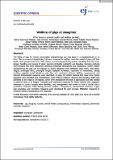Por favor, use este identificador para citar o enlazar a este item:
http://hdl.handle.net/10261/238922COMPARTIR / EXPORTAR:
 SHARE SHARE
 CORE
BASE CORE
BASE
|
|
| Visualizar otros formatos: MARC | Dublin Core | RDF | ORE | MODS | METS | DIDL | DATACITE | |

| Título: | Welfare of pigs at slaughter |
Autor: | Saxmose Nielsen, Søren; Álvarez, Julio CSIC ORCID; Bicout, Dominique Joseph; Calistri, Paolo; Depner, Klaus; Drewe, Julian Ashley; Garin‐Bastuji, Bruno; Gonzales Rojas, Jose Luis; Gortázar, Christian CSIC ORCID ; Michel, Virginie; Miranda Chueca, Miguel Ángel; Roberts, Helen Clare; Sihvonen, Liisa Helena; Spoolder, Hans; Ståhl, Karl; Viltrop, Arvo; Winckler, Christoph; Candiani, Denise; Fabris, Chiara; Stede, Yves van der; Velarde Calvo, Antonio | Fecha de publicación: | 2020 | Editor: | Wiley-VCH | Citación: | EFSA Journal 18(6): e06148 (2020) | Resumen: | The killing of pigs for human consumption (slaughtering) can take place in a slaughterhouse or on farm. The processes of slaughtering that were assessed for welfare, from the arrival of pigs until their death, were grouped into three main phases: pre‐stunning (including arrival, unloading from the truck, lairage, handling and moving of pigs); stunning (including restraint); and bleeding. Stunning methods were grouped into three categories: electrical, controlled atmosphere and mechanical. Twelve welfare consequences the pigs can be exposed to during slaughter were identified: heat stress, cold stress, fatigue, prolonged thirst, prolonged hunger, impeded movement, restriction of movements, resting problem, negative social behaviour, pain, fear and respiratory distress. Welfare consequences and relevant animal‐based measures were described. In total, 30 welfare hazards that could occur during slaughter were identified and characterised, most of them related to stunning and bleeding. Staff were identified as the origin of 29 hazards, which were attributed to the lack of appropriate skill sets needed to perform tasks or to fatigue. Corrective and preventive measures for these hazards were assessed: measures to correct hazards were identified, and management was shown to have a crucial role in prevention. Outcome tables linking hazards, welfare consequences, animal‐based measures, origins and preventive and corrective measures were developed for each process. Mitigation measures to minimise welfare consequences are proposed. | Descripción: | EFSA Panel on Animal Health and Welfare (AHAW). | Versión del editor: | https://doi.org/10.2903/j.efsa.2020.6148 | URI: | http://hdl.handle.net/10261/238922 | DOI: | 10.2903/j.efsa.2020.6148 | E-ISSN: | 1831-4732 |
| Aparece en las colecciones: | (IREC) Artículos |
Ficheros en este ítem:
| Fichero | Descripción | Tamaño | Formato | |
|---|---|---|---|---|
| welfpig.pdf | 15,39 MB | Adobe PDF |  Visualizar/Abrir |
CORE Recommender
PubMed Central
Citations
24
checked on 14-abr-2024
SCOPUSTM
Citations
37
checked on 21-abr-2024
WEB OF SCIENCETM
Citations
29
checked on 27-feb-2024
Page view(s)
57
checked on 24-abr-2024
Download(s)
107
checked on 24-abr-2024

